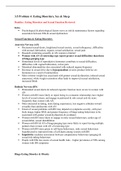3.5 Problem 4: Eating Disorders, Sex & Sleep
Dunkley: Eating Disorders and Sexual Function Reviewed
Intro
Psychological & physiological factors serve as risk & maintenance factors regarding
association between EDs & sexual dysfunction
Sexual Function & Eating Disorders
Anorexia Nervosa (AN)
Decreased sexual desire, heightened sexual anxiety, sexual infrequency, difficulties
with arousal, lubrication, orgasm, sexual satisfaction, sexual pain
Research examining sexuality in AN women is limited
Women with AN of restricting type report greater sexual difficulties than those
of binge-purging type
Diminished levels of reproductive hormones contribute to sexual difficulties,
difficulties with vaginal lubrication, vulvar pain
Menstrual abnormalities also associated with reduced orgasm frequency
Decrease in sexual drive due to hypogonadism (ovaries produce little/no sex
hormones) as a result of malnutrition
More extreme weight loss associated with greater sexual dysfunction, reduced sexual
enjoyment, while weight restoration often leads to improved sexual satisfaction,
increased libido
Bulimia Nervosa (BN)
Diminished sexual desire & reduced orgasmic function more severe in women with
AN
Women with BN more likely to report being in a romantic relationship, have higher
levels of sexual esteem, and engage in partnered & solo sexual activity more
frequently than women with AN
More interested in dating, more dating experiences, less negative attitudes toward
sexuality than adolescents with AN
Extent of sexual problems with BN may depend on symptoms severity, with poor
body image, higher BMI, and greater frequency of binge-eating behaviours to be
associated with greater sexual dysfunction & avoidance
Women with BN more likely to engage in risky sexual behaviours; earlier age of
sexual debut, sexual disinhibition
Women with BN & AN of binge/purging type more likely to report having multiple
partners than women with AN of restricting type
Women with BN more prone to self-harm behaviours; risky sexual behaviours
hypothesized to represent forms of self-harm among women with BN
Impulsivity mediates association between compensatory behaviours (purging) &
sexual risk-taking behaviours
People with EDs less aware of sexual health risks – higher prevalence of STIs among
women with BN symptoms
Binge-Eating Disorder & Obesity
, Sexual function of obese with BED was more impaired compared with obese subjects
without BED and controls
Greater frequency of binge-eating episodes correlated with lower orgasmic ability,
sexual satisfaction, and overall sexual function
Emotional eating associated with sexual dysfunction of women with BED
It is possible that most of the effects of BED on sexual function are due to being
overweight
Longitudinal & Treatment Research
Long-term course of AN: women who recovered reported improvements in sexual
problems
Sexual problems, coupled with impulsivity, long duration of inpatient treatment, and
long duration of an ED, predicted 45% of variance in outcome at 12-year follow-up
Women with history of CSA didn’t show significant improvement in sexual function
following treatment; history of CSA may moderate relationship between ED
psychopathology & sexual function
Sexual function tends to improve alongside reductions in eating pathology, but
psychosexual & etiological factors may influence this association
Men and Sexual/Gender Minorities
Research on sexuality & eating pathology in men is relatively non-existent
Non-heterosexual men are at greater risk of developing ED; minority stress, cultural
pressures concerning physical appearance among men of same-sex attraction
Lower prevalence of AN & BN in men (but perhaps higher in non-hetero men? Not
enough research)
Those who identify as transgender/non-binary report greater prevalence of EDs
Non-Clinical Samples (women without ED diagnosis)
Binge-purge symptoms, body dissatisfaction, and drive for thinness associated with
more body and performance-based cognitive disruptions during sexual activity, as
well as lower sexual self-efficacy
Disordered eating associated with lower sexual arousal, satisfaction, lubrication,
sexual pain
Dysfunctional body image & binge-eating tendencies similarly associated with greater
sexual distress
Eating Disorders & Sexual Dysfunction as Internalizing Psychopathology
Etiological factors involved in EDs may contribute to manifestation of sexual
difficulties, psychological factors like depression, anxiety, poor body image, certain
personality characteristics, may underlie connection between disordered eating &
sexual concerns
Body image issues are seen in both sexual difficulties & EDs
Disturbance of body image is a primary feature of all EDs, and most common age of
onset for EDs is around puberty, which involves development of secondary sex
characteristics and corresponding changes in body image
Body dysmorphia: greater sexual dysfunction, lower sexual satisfaction in women
both with and without an ED diagnosis
Positive body esteem linked to more frequent sexual experiences, higher sexual
esteem, greater sexual desire, sexual pleasure, orgasmic frequency, lower sexual
anxiety, less sexual dysfunction, fewer risky sexual behaviours in women without ED





